Class 12 Biology Sample Papers 2025
Access the latest CBSE Class 12 Biology Sample Papers for the academic year 2024-25 on the myCBSEguide app and on our myCBSEGuide website. These sample papers are designed according to the revised syllabus and new marking scheme released by CBSE, ensuring you are well-prepared for your exams. Prepare for the 2025 exams with the most recent Class 12 Biology sample test papers designed by experts.
- Updated Sample Papers: The 2025 sample papers reflect the changes in the exam pattern and syllabus, helping you familiarize yourself with the new format.
- Free Access: Download these question papers in PDF format for free from the app and website, making it easy to study offline.
Key Features of CBSE Class 12 Biology Sample Papers 2025
- Revised Exam Pattern: Practice with questions based on the latest guidelines and marking scheme for accurate exam preparation.
- Comprehensive Solutions: Each sample paper comes with solutions to help you understand the correct approach and improve problem-solving skills.
How to Download Class 12 Biology Sample Papers
- Download the myCBSEguide App.
- Visit the myCBSEguide Website for direct access.
- Start Practicing: Download the updated sample papers and start preparing.
Prepare smartly with the best resources! Download the Class 12 Biology sample papers now.
Download the CBSE Class 12 Biology Sample Paper 2024-25 from myCBSEguide to practice the latest exam pattern and marking scheme.
Sample Papers of Biology class 12 – free PDF Download
Download CBSE Class 12 Biology Sample Papers 2025
Prepare for your CBSE Class 12 Biology exams with the latest sample papers for 2025, created according to the revised marking scheme and blueprint by CBSE. These sample papers are available for free download in PDF format on the myCBSEguide app and website. The updated papers are designed to help students practice effectively, understand the exam structure, and answer key questions like “How to prepare for CBSE board exams?” Download the CBSE Class 12 Biology sample papers today for comprehensive practice and exam readiness.
How to Download CBSE Class 12 Biology Sample Papers
To get the 2025 CBSE Class 12 Biology sample papers, simply download the myCBSEguide app from the app store. Once installed, you can access the sample papers in PDF format and start practicing. Alternatively, visit the myCBSEguide website for direct downloads. The sample papers are designed to align with the updated syllabus and exam pattern, helping you gain confidence in answering questions and solving problems effectively. Use these papers for exam practice, along with the provided solutions and explanations, to enhance your understanding and improve exam strategies.
These Class 12 Biology Sample Papers 2025 are designed to help students master the concepts and perform well in exams.
Sample Papers of Class 12 Biology 2025 with solution
Sample Papers of Class 12 Biology
myCBSEguide offers free CBSE Class 12 Biology sample papers for 2025, available for easy PDF download. These papers are based on the latest CBSE syllabus, NCERT books, and the updated marking scheme, ensuring accurate exam practice. Students can access these sample papers, along with solutions, to enhance their preparation. The papers follow the current CBSE blueprint and are available for all subjects via the myCBSEguide app. Practice with these sample papers today to improve your problem-solving skills and boost your confidence for the upcoming exams.

CBSE Sample Papers Class 12 Biology 2024
Class 12 – Biology
Sample Paper – 01 (2024-25)
Maximum Marks: 70
Time Allowed: : 3 hours
General Instructions:
- All questions are compulsory.
- The question paper has five sections and 33 questions. All questions are compulsory.
- Section–A has 16 questions of 1 mark each; Section–B has 5 questions of 2 marks each; Section– C has 7 questions of 3 marks each; Section– D has 2 case-based questions of 4 marks each; and Section–E has 3 questions of 5 marks each.
- There is no overall choice. However, internal choices have been provided in some questions. A student has to attempt only one of the alternatives in such questions.
- Wherever necessary, neat and properly labeled diagrams should be drawn.
- Section A
- Which of the following relations is correct regarding GPP and NPP of an ecosystem?
a) NPP = GPP + Animal consumptionb) NPP = GPP – Plant respirationc) NPP = GPP + Plant respirationd) NPP = GPP – Animal consumption
- The periodic abstinence by a couple for family planning should be from:
a) Day 13 to 15 of menstrual cycleb) Day 16 to 20 of menstrual cyclec) Day 5 to 10 of menstrual cycled) Day 10 to 17 of menstrual cycle
- In which of the zone of biosphere reserves human activity is not allowed
a) Manipulation zoneb) Buffer zonec) Transition zoned) Core or natural zone
- Emergency contraceptives are effective if used within:
a) 72 hrs of implantationb) 72 hrs of menstruationc) 72 hrs of ovulationd) 72 hrs of coitus
- Automated DNA seuqences, work on the principle of the method developed by:
a) Maurice Wilkinsb) Frederick Sangerc) Francis Crickd) Erwin Chargaff
- Biogas is a:
a) Poisonous gasb) Harmful gasc) Methane rich fueld) Greenhouse gas
- Represented below is the inheritance pattern of a certain type of trait in humans. Which one of the following conditions could be an example of this pattern?
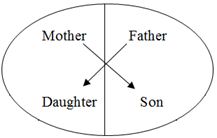 a) Thalassemiab) Haemophiliac) Sickle Cell anemiad) Phenyl ketonuria
a) Thalassemiab) Haemophiliac) Sickle Cell anemiad) Phenyl ketonuria - Picture shown below is an example of:-
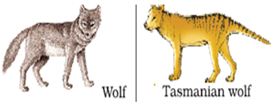 a) Convergent evolution of Australian marsupials and placental mammalsb) Divergent evolution of Australian marsupials and placental mammalsc) Homologous organs of both animalsd) Analogous organs of both animals
a) Convergent evolution of Australian marsupials and placental mammalsb) Divergent evolution of Australian marsupials and placental mammalsc) Homologous organs of both animalsd) Analogous organs of both animals - Which of the following groups are absolutely essential functional components of an ecosystem?
a) Detritivoresb) Producers and herbivoresc) Producers and detritivoresd) Producers
- Which one of the following symbols and its representation used in the human pedigree analysis is correct?
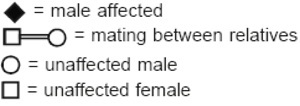 a) unaffected femaleb) unaffected malec) affected maled) Mating between relatives
a) unaffected femaleb) unaffected malec) affected maled) Mating between relatives - Which of the following is mainly produced by the activity of anaerobic bacteria on sewage?
a) Laughing gasb) Propanec) Marsh gasd) Mustard gas
- Viral genome incorporated into host DNA is called:
a) Transposonb) Prophagec) Prophased) Bacteriophage
- Assertion (A): Periodic abstinence is a natural method of birth control.
Reason (R): In this male partner withdraws his penis from the vagina just before ejaculation so as to avoid insemination.a) Both A and R are true and R is the correct explanation of A.b) Both A and R are true but R is not the correct explanation of A.c) A is true but R is false.d) A is false but R is true. - Assertion (A): Curdling is required in the manufacture of cheese.
Reason (R): Lactic acid bacteria and rennet is used for this purpose.a) Both A and R are true and R is the correct explanation of A.b) Both A and R are true but R is not the correct explanation of A.c) A is true but R is false.d) A is false but R is true. - Assertion (A): Ecological pyramids are also called Eltonian pyramids.
Reason (R): An ecological pyramid is always upright.a) Both A and R are true and R is the correct explanation of A.b) Both A and R are true but R is not the correct explanation of A.c) A is true but R is false.d) A is false but R is true. - Assertion (A): Organic evolution explains that new species originated from pre-existing life forms and there is gradual variation in trait to adjust in particular habitats.
Reason (R): Existing living forms share similarities to various degrees among themselves and also with life forms that existed millions of years ago.a) Both A and R are true and R is the correct explanation of A.b) Both A and R are true but R is not the correct explanation of A.c) A is true but R is false.d) A is false but R is true.
Prepare for Exams with myCBSEguide App
Download the myCBSEguide App for comprehensive study material tailored to your exam needs. Whether you’re preparing for CBSE, NCERT, JEE (Main), NEET-UG, or NDA exams, this app provides all the resources you need to excel.
- Complete Study Material: Access notes, sample papers, previous years’ papers, and more.
- CBSE, NCERT, JEE (Main), NEET-UG & NDA: Ideal for students preparing for various competitive exams.
Examin8.com App for Teachers
The Examin8 App allows educators to create customized exam papers with their name and logo. You can refine and personalize your practice papers to fit your teaching style.
- Create Custom Papers: Design and refine papers to match your curriculum.
- Personalize with Logo: Add your branding to the papers.
- Enhance SEO: Optimize your content for better search engine ranking.
Why Choose myCBSEguide & Examin8?
- For Students: All-in-one platform for exam preparation. Visit myCBSEGuide website and Examin8
- For Teachers: Easily customize exam papers to suit your classroom needs.
Download now and take your exam preparation to the next level!
Section B
- Name the group of organisms and the substrate they act on to produce biogas.
- Answer the questions based on the dinucleotide show below.

- Name the type of sugar to which guanine base is attached to.
- Name the linkage connecting the two nucleotides.
- Identify the 3′ end of the dinucleotide. Give a reason for your answer.
- Mention the advantages of emasculation and bagging in artificial hybridization in plants bearing unsexual and bisexual flowers.
- In the given figure, give the name and functions of parts labelled A and B.
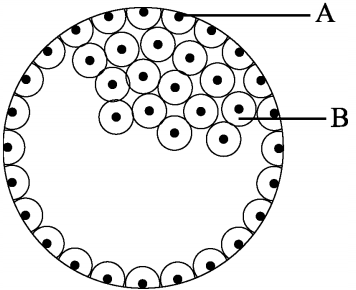
- Curd is easier to digest by humans than milk. Justify, giving two suitable reasons. OR Name the microbes that help production of the following products commercially:
(a) Statin
(b) Citric acid
(c) Penicillin
(d) Butyric acid
Section C
- Study the figure given and answer the questions.
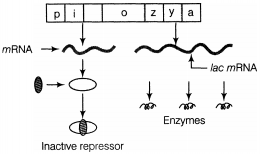
- How does the repressor molecule get inactivated?
- When does the transcription of lac mRNA stop?
- Name the enzyme transcribed by the gene z.
- Write any six salient features of the human genome as drawn from the human genome project.
- How does the floral pattern of Mediterranean orchid Ophrys guarantee cross-pollination?
- A schematic diagram of matured human insulin is given below:

How is the process of its formation naturally in the human body different from that of its formation by rDNA technology? Explain. - Bio-diversification of life started to occur almost 3 billion years ago. Since then new species have been evolving and then disappearing en masse from earth.
- How many episodes of mass extinctions of species have already taken place and which one is in progress in the current era?
- How is current episode in progress different from the previous episodes and why? Explain.
OR
How have the following factors affected the biodiversity of an area? Explain.
- Habitat loss and fragmentation
- Over-exploitation
- Mention the contribution of S.L. Miller’s experiment on Origin of Life.
- Name the causative organisms for the following diseases
- Elephantiasis
- Ringworm
- Amoebiasis
- How can public hygiene help control such diseases?
- Name the causative organisms for the following diseases
Section D
- Read the following text carefully and answer the questions that follow:
After implantation, finger-like projections appear on the trophoblast called chorionic villi which are surrounded by the uterine tissue and maternal blood. The chorionic villi and uterine tissue become interdigitated with each other and jointly form a structural and functional unit between the developing embryo (foetus) and the maternal body.

- Name the hormone crucial in parturition. Does the parturition signal originate from the mother or the fetus? (1)
- When and where do chorionic villi appear in humans? (1)
- Woman has conceived and implantation has occurred. Discuss the impact of progesterone and estrogen. (2)
OR
Fetal ejection reflex leads to parturition. Justify (2)
- Read the following text carefully and answer the questions that follow:
When a microorganism invades a host, a definite sequence of events usually occur leading to infection and disease, causing suffering to the host. This process is called pathogenesis. Once a microorganism overcomes the defense system of the host, development of the disease follows a certain sequence of events as shown in the graph. Study the graph given below for the sequence of events leading to appearance of a disease and answer the questions that follow:
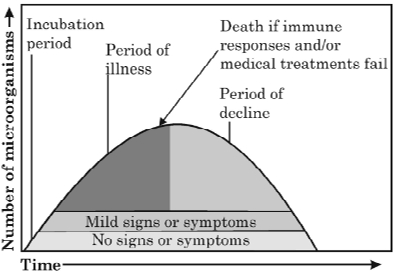 :
:
- In which period, according to the graph there are maximum chances of a person transmitting a disease/infection and why? (1)
- Study the graph and write what is an incubation period. Name a sexually transmitted disease that can be easily transmitted during this period. Name the specific type of lymphocytes that are attacked by the pathogen of this disease. (1)
- Draw a schematic labelled diagram of an antibody. (2)
OR
In which period, the number of immune cells forming antibodies will be the highest in a person suffering from pneumonia?
Name the immune cells that produce antibodies. (2)
Section E
-
- When we squeeze a seed of an orange, many embryos, instead of one are observed. Explain, how it is possible.
- Are these embryos genetically similar or different? Comment.
- OR Justify the following statements:
- Most zygotes in angiosperms divide only after a certain amount of endosperm is formed.
- Groundnut seeds are exalbuminous and castor seeds are albuminous.
- Micropyle remains as a small pore in the seed coat of a seed.
- Integuments of an ovule hardens and the water content is highly reduced as the seed matures.
- Apple and cashew nuts are not called true fruits.
- How are the structural genes activated in the lac operon in E. coli? OR
- Describe aminoacylation of tRNA.
- Explain the process that takes place in the ribosomes when mRNA makes its entry into it in a prokaryote.
- Due to transcription error, ATG codon of DNA is transcribed into UAG in mRNA which translates a non-functional polypeptide chain in the ribosome. Justify the statement.
- Why is Taq polymerase preferred in PCR? Mention the source of this enzyme. ORDNA fragmentation is the separation or breaking of DNA strands into pieces. It can be done intentionally by laboratory personnel or by cells, or can occur spontaneously. Spontaneous or accidental DNA fragmentation is fragmentation that gradually accumulates in a cellStudy the diagram given below and answer the following questions.

- Why have DNA fragments in band D moved farther away in comparison to those in band C?
- Identify the anode end in the diagram.
- How are these DNA fragments visualised?
Prepare for Exams with myCBSEguide App
Download the myCBSEguide App for comprehensive study material for CBSE, JEE, NEET, and NDA exams. Access notes, papers, and more.
“Access study material anytime, anywhere.
Examin8.com: Custom Exam Paper Creation for Teachers
Examin8.com App helps teachers create custom exam papers with logos, enhancing personalized assessments and simplifying exam creation and distribution.
Why Choose myCBSEguide & Examin8?
For Students: Access complete study resources for CBSE, JEE, NEET, and NDA to ace your exams efficiently.
For Teachers: Create customized exam papers with your name and logo, saving time and personalizing assessments for students.
Class 12 – Biology
Sample Paper – 01 (2024-25)
Solution
Section A
-
-
- (c)NPP = GPP + Plant respiration. Explanation:NPP = GPP + Plant respiration
- (d)Day 10 to 17 of menstrual cycle. Explanation:In day 10 to 17 of menstrual cycle periodic abstinence by couple for family planing.
- (d)Core or natural zone. Explanation:There are three zones of any biosphere reserves core zone, buffer zone, and transition zone. In the core zone or natural zone, human activity is not permitted at all.

- (d)72 hrs of coitus. Explanation:Administration of progestogens or progestogen-estrogen combinations or IUDs within 72 hours of coitus has been found to be very effective as emergency contraceptives as they could be used to avoid possible pregnancy due to rape or casual unprotected intercourse.
- (b)Frederick Sanger. Explanation:Frederick Sanger
- (c)Methane rich fuel. Explanation:Anaerobic decomposition of biomass like cow dung release biogas. This biogas contains mainly methane gas and can be used as fuel for cooking and lighting.
- (b)Haemophilia. Explanation:The inheritance pattern of a certain type of trait in humans shown above is haemophilia.
A son cannot inherit the defective gene from his father. This is a recessive trait and can be passed on if cases are more severe with the carrier. Genetic testing and genetic counselling are recommended for families with haemophilia. The disease is X-linked and the father cannot pass haemophilia through the Y-chromosome. - (a)Convergent evolution of Australian marsupials and placental mammals. Explanation:Wolf and Tasmania Wolf are examples of convergent evolution of placental mammals and Australian marsupials. They are evolved differently due to different in climatic and geographic regions.
- (c)Producers and detritivores. Explanation:Producers and detritivores
- (d)Mating between relatives. Explanation:The symbols and its representation used in the human pedigree analysis is mating between relatives is correct.
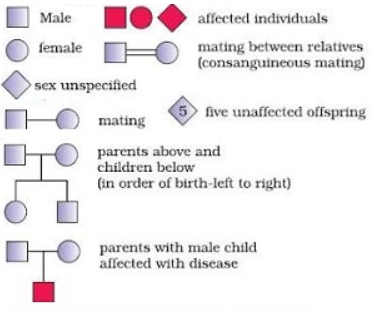
- (c)Marsh gas. Explanation:Anaerobic bacteria are used in the water treatment process during which marsh gas is produced. This gas has a pungent smell and highly flammable.
- (b)Prophage. Explanation:Prophage
- (c)A is true but R is false. Explanation:A is true but R is false.
- (b)Both A and R are true but R is not the correct explanation of A. Explanation:The manufacture of cheese requires two main steps curdling and ripening. Curdling the milk proteins forms a solid material from which the liquid is drained away. The curdling process may be exclusively microbiological since acid production of lactic acid bacteria is sufficient to coagulate milk proteins. However, an enzyme is known as rennin (extracted from the stomachs of calves or rennet) which curdles milk is often used for this purpose.
- (c)A is true but R is false. Explanation:Ecological pyramids were developed by Charles Elton and are, therefore, also called Eltonian pyramids. An ecological pyramid can be upright, inverted or spindle shaped depending upon criteria of formation of pyramid (like energy, biomass or number) and the type of food chain involved parasitic, aquatic or terrestrial.
- (a)Both A and R are true and R is the correct explanation of A. Explanation:Organic evolution is the events involved in the evolutionary development of a species. It means that all life descended from other life, although features may have changed dramatically along the way.
Charles Robert Darwin collected observations on animal distribution and the relationship between the living and extinct animals. He found that existing living forms share similarities to varying degrees not only among themselves but also with the life forms that existed millions of years ago, some of which have become extinct.
-
Enhance Your Exam Preparation with the myCBSEguide App
Boost your exam readiness by downloading the myCBSEguide.com app. It offers comprehensive learning resources for CBSE, NCERT, JEE (Main), NEET-UG, and NDA exams, helping you ace your tests.
- Complete Learning Resources: Access study notes, sample papers, practice questions, and more for various competitive exams.
- All-in-One Study Companion: Get everything you need to succeed in CBSE, JEE, NEET, and NDA exams.
Examin8.com: Custom Exam Paper Creation for Educators
Teachers, streamline your exam creation process with the Examin8.com app. This tool allows you to design personalized exam papers with your name, logo, and other unique branding elements.
- Customizable Exam Papers: Create tailored test papers aligned with your teaching style and students’ needs.
- Branding & Personalization: Add your logo and other custom features to make your exams stand out.
Why Choose myCBSEguide & Examin8?
- For Students: Access a vast library of study material for CBSE, JEE, NEET, and NDA exams, designed for exam success.
- For Teachers: Generate personalized exam papers effortlessly, enhancing both your teaching experience and students’ learning.
Section B
- Methanogens are anaerobic unicellular organisms, that release methane as a waste product of cellular metabolism.
Substrate: Cellulosic materials / cow dung.
- Pentose sugar or deoxyribose sugar.
- Two nucleotides are linked through 3′-5′ phosphodiester linkage to form a dinucleotide.
- The ribose sugar has a free 3′-OH group which is referred to as 3′ end of the polynucleotide chain.
- The advantages of emasculation and bagging in artificial hybridization in plants bearing unsexual and bisexual flowers areUnisexual-
- There is no need of emasculation in female flowers
- flowers are bagged before opening to prevent pollination by undesirable pollen grain
- they contaminated with undesirable pollen
Bisexual-
- Removal of anthers is easy
- emasculation before dehiscence
- bagging to avoid contamination of stigma from unwanted pollen
- = Trophoblast – Gets attached to the endometrium and draws nutritive material secreted by uterine endometrium gland.
- = Inner cell mass – Differentiates as Embryo.
- LAB produce acids that coagulate milk
- Partially digests milk proteins
- OR
- Monascus purpureus
- Aspergillus niger
- Penicillium notatum
- Clostridium butylicum.
Section C
-
- When an inducer, e.g., lactose binds to the repressor, the repressor is inactivated.
- The transcription of lac mRNA stops when lactose becomes exhausted or when there is no need for energy to the cells.
- β-galactosidase.
- The salient features of the human genome as drawn from the human genome project are as follows:
- The human genome contains 3164.7 million nucleotide bases.
- The average gene consists of 3000 bases but sizes vary greatly with the largest known human gene being dystrophin at 2.4 million bases.
- The total number of genes is estimated at 30,000 – much lower than previous estimates
- Almost all (99.9 per cent) nucleotide bases are exactly the same in all people.
- The functions are unknown for over 50 per cent of discovered genes.
- Less than 2 per cent of the genome codes for proteins.
- In the flowers of Ophrys:
- One petal resembles the female of a bee species in size, colour, markings, etc.
- Male bee perceives it as a female and pseudocopulates with it.
- During the process, the pollen grains from the anthers get dusted on the body of the bee.
- When the bee is attracted to another flower of this orchid species, the process is repeated and the pollen grains from the body of the bee get dusted on the stigma thus, cross-pollination is achieved.
- Insulin production in human body:
- Synthesised naturally in the form of proinsulin consisting of polypeptide chain A and polypeptide chain B, linked together by disulphide bonds and an extra stretch called C-peptide
- The C-peptide is removed during processing and proinsulin matures into functional insulin.
Insulin production by rDNA technology
- Two DNA sequences corresponding to chain A and chain B of human insulin are synthesised
- They are introduced into two different plasmids of E.coli
- Chain A and chain B are produced separately
- extracted and combined by disulphide bond to form human insulin.
-
- Five extinctions have already occurred
- Sixth is in progress OR
-
- Habitat loss- loss of habitat leads to loss of biodiversity and threatens the survival of plants and animals to extinction.
- Fragmentation- ammals and birds requiring large territories and certain animals with migratory habits are badly affected due to fragmentation, leading to population decline.
- Many commercially important species are overharvested, endangering their existence which may lead to their extinction.
-
- Stanley Miller, in 1953, created similar conditions in a laboratory as of the early atmosphere of earth (high temperature, volcanic storms, reducing atmosphere containing methane, ammonia, etc.). He created electric discharge in a closed flask containing CH4, H2, NH3, water vapors at 800oC and observed the formation of amino acids. In similar experiments, sugars, nitrogen bases, pigments, and fats were also observed. Analysis of meteorite content also revealed similar compounds indicating that similar processes are occurring elsewhere in space. This formation of organic molecules from inorganic molecules is known as chemical evolution.
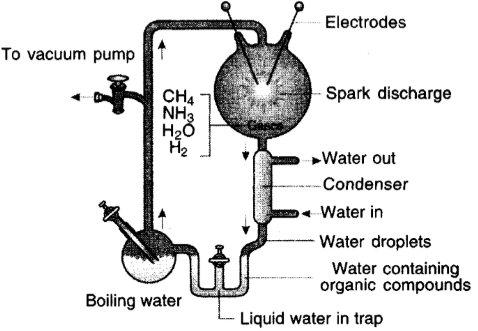
- The causative agents or organisms for following diseases are:
- Elephantiasis- Wuchereria bancrofti
- Ringworm- Microsporum
- Amoebiasis-Entamoeba histolytica
- Maintenance of public hygiene includes:
- keeping body and surroundings clean.
- consumption of clean drinking water, fruits and vegetables, etc.
- proper disposal of waste and excreta.
- regular cleaning and disinfection of tanks and other water reservoirs, etc.
- all the above measures help to control the increase in vectors of infectious diseases and their breeding places. Thus, there would be reduced chances of transmission of infectious diseases.
- The causative agents or organisms for following diseases are:
Section D
- The hormone is Oxytocin. The signal originates from the placenta and fully developed fetus which initiate the foetal ejection reflex triggering the release of the hormone, oxytocin.
- After implantation, finger-like projections appear on the trophoblast called chorionic villi. They are surrounded by uterine tissue and maternal blood.
- Under the impact of progesterone and estrogen the size of the uterus and birth canal increases. Relaxation of pelvic ligament takes place. The placenta is developed between chorionic and uterine tissues.
OR
Fully developed foetus pushes down the birth canal, causing stretching of the cervix. This generates nerve impulse which stimulates the hypothalamus. It in turn causes the posterior pituitary to release oxytocin (birth hormone). Oxytocin causes the uterine muscles to contract more vigorously which leads to parturition.
-
- Period of illness: The number of disease-causing microorganisms reaches its maximum during the period of illness so, there are maximum chances of a person transmitting a disease/infection at this stage.
- Time period between infection and appearance of its symptoms is known as incubation period.
AIDS/any other correct example
T lymphocytes are attack by the pathogen of this disease. 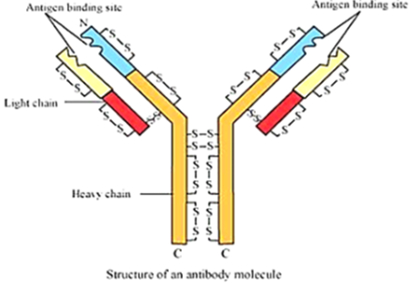
OR
Period of illness
B lymphocytes/B cells produces antibodies.
Section E
-
- It is true that when we squeeze a seed of an orange, many embryos, instead of one are observed. It occurs mainly due to a process called polyembryony.
It is a phenomenon of occurrence of more than one embryo in a seed. It was first described by Antony van Leeuwenhoek (1719) in Citrus.
Polyembryony can be spontaneous or induced experimentally. The polyembryony may arise by the following reasons:- Formation of additional embryos from synergids or from antipodals and polar nuclei (very rare).
- Some embryos can also be derived by the activation of some sporophytic cells of ovule such as nucellus or integument.
- Embryos can also be developed from an additional embryo sac in the same ovule.
- The embryos formed as a result of polyembryony are genetically similar to one another. However, the embryos arising from gametophytic tissues are similar to each other, but not to their parents. The embryos that are derived from sporophytic tissues are usually similar to each other as well as their parents. OR
- Zygotes in angiosperms mostly divide only after a certain amount of endosperm is formed as an adaptation strategy to assure nutrition for the developing embryo.
- Groundnut seeds are exalbuminous because the developing embryo utilizes the endosperm completely. So, there is no endosperm left in the seed.
- Castor seeds are albuminous because the endosperm is not completely used up by the developing embryo. There is some amount of endosperm left in the seeds always.
- Micropyle allows entry of water and oxygen during seed germination.
- During unfavorable conditions, seeds become dormant. The loss of water reduces the metabolic activity of seeds and hardens the integuments.
- In these fruits, thalamus contributes to fruit formation. So, they are not called true fruits.
- It is true that when we squeeze a seed of an orange, many embryos, instead of one are observed. It occurs mainly due to a process called polyembryony.
- In the lac-operon in E.coli, three structural genes z, y and a are present. These genes code for different polypeptides, z-gene codes for beta-galactosidase to break lactose into galactose and glucose, y-zene codes for permease which facilitates entry of lactose and the a-gene codes or transacetylase. Presence or absence of lactose in the cell regulates switch on or off operon and is termed inducer. The lactose in the cell combines with the repressor protein synthesised by i-gene to form inactive repressor which does not bind to operator gene and the RNA polymerase from promoter gene moves to the structural genes to help in transcription. In the absence of lactose, the repressor binds to the operator gene and RNA polymerase cannot move from promoter gene, and thus there is no transcription. OR
- In the first phase itself, amino acids are activated in the presence of ATP and linked to their cognate tRNA–a process commonly called as charging of tRNA or aminoacylation of tRNA to be more specific. If two such charged tRNAs are brought close enough, the formation of a peptide bond between them would be favored energetically.
- Small subunit of ribosome binds to mRNA at start codon (AUG) at 5’ end, in the two sites of large subunits of ribosome, the charged tRNA with the aminoacid corresponding to the codon on mRNA align, formation of peptide bond between the two closely placed amino acids in the two sites occur, with the help of ribozyme in the ribosome, peptide chain elongation continues till the stop codon (UAG, UGA, UAA) on the mRNA reach the big unit of ribosome.
- Due to transcription error, ATG codon of DNA is transcribed into UAG in mRNA which translates a non-functional polypeptide chain in the ribosome. This means that due to transcription error i.e presence of G in place of C there will be a synthesis of incorrect protein. Since the codon, UAG stops codon and it will cause termination of the polypeptide chain synthesis.
- Role of Heat – In PCR (in vitro), the DNA strands are separated by heating them at 95°C for 2 minutes. Heating causes the breakdown of H-bonds between the bases of two strands leading to their unwinding.
Role of Primers – Primers are short lengths of DNA about 20bp long that are required to start DNA polymerisation in PCR. The primers hybridise to their complementary sequence on the DNA strands at 40-50°C temperature and help in DNA polymerisation.
Role of Thermus aquaticus – An enzyme called Taq polymerase is isolated from Thermus aquaticus. Since this bacterium thrives in temperature as high as 95oC, this enzyme can also tolerate high temperature without undergoing denaturation. Therefore, this enzyme is used in PCR instead of normal DNA polymerase. OR- In band D, DNA fragments are smaller than those on band C. The fragments separate according to their size through the sieving effect provided by the gel. So, the smaller fragments move farther away than the larger ones.
- B is anode end in the diagram
- Gel containing DNA fragment is stained with ethidium bromide and exposed to UV radiation Orange colour bands of DNA become visible.
Visit our website myCBSEGuide To practice more questions & prepare well for exams, download myCBSEGuide App. It provides complete study material for CBSE, NCERT, JEE (main), NEET-UG and NDA exams. Teachers can use Examin8.com App to create similar papers with their name and logo.
2025 CBSE Class 12 Biology mock papers are available for download to enhance your exam preparation.
Get the latest 2025 Biology practice papers for Class 12 to familiarize yourself with the new exam pattern.
Download free sample papers today.
CBSE Sample Papers for Class 12
- Physics
- Chemistry
- Mathematics
- Biology
- English Core
- Business Studies
- Economics
- Accountancy
- Computer Science
- Informatics Practices
- Hindi Core
- Hindi Elective
- History
- Political Science
- Geography
- Home Science
- Physical Education
- Other Subjects
Download CBSE Class 12 Sample Papers 2024-25: Complete Study Materials & Practice Sets
Prepare thoroughly for your board exams with the Class 12 Biology Sample Papers 2025 and expert solutions provided available
Looking for high-quality CBSE Class 12 sample papers 2024-25? Access comprehensive study materials for all major subjects including Mathematics, Physics, Chemistry, Biology, History, Political Science, Economics, Geography, Computer Science, Home Science, Accountancy, and Business Studies through myCBSEguide’s platform.
Key Resources Available:
- Chapter-wise sample papers with detailed solutions
- Subject-specific test papers for focused practice
- Complete NCERT solutions and NCERT Exemplar answers
- Quick revision notes for last-minute preparation
- Previous years’ question papers and CBSE guess papers
- Important questions bank curated by expert educators
Why Choose myCBSEguide?
✓ Subject-wise organized content
✓ Updated according to the latest CBSE syllabus
✓ Available on both mobile app and website
✓ Expert-verified solutions
✓ Free study materials and resources
✓ User-friendly interface

Test Generator
Create question paper PDF and online tests with your own name & logo in minutes.
Create Now
Learn8 App
Practice unlimited questions for Entrance tests & government job exams at ₹99 only
Install Now